Moto G Review: The Last True "Motor"
Moto G really is the latest authentic Motorola smartphone: as you know, on January 29, the American company bought Lenovo. Yes, Motorola lost its independence back in 2012, when it was swallowed by Google. However, the Motorola products that came out after this event, in my opinion, were nevertheless authentic: Google is not an “iron” company, and it hardly interfered seriously with the device creation process. Lenovo is another matter: this manufacturer has its own vision of the right smartphones and extensive experience in creating them, so the following Motorola devices may already have a noticeable Chinese flavor. (In this case, under the "Chinese flavor" is not meant to be low quality, namely, the strokes inherent in the Lenovo device - design, software, and so on.)

Lenovo K900 and Moto G
Anyway, today we’ll talk specifically about Moto G. On the Internet, it’s customary to praise this device - they say, the best budget offer, an excellent smartphone for “crutches of dandies”, a killer of products of local Russian brands and so on. Yes, indeed, I will already run ahead now and say that the smartphone is decent. And it may very well be that I will leave it for a couple of months as a second device. But, at the same time, I can’t stop smoking a bit - I have enough reasons for this, as a user of a number of Android-based Motorola smartphones from 2010-2011, suffices.
What have I always liked “Motors” with Android inside? Unusual approach to design and software. (I should immediately say that I am not a fan of the stock versions of this OS and I love all sorts of shells with small pleasant chips.) For example, the Motorola Milestone XT720 is one of the latest Motorola devices shipped to Russia.
')
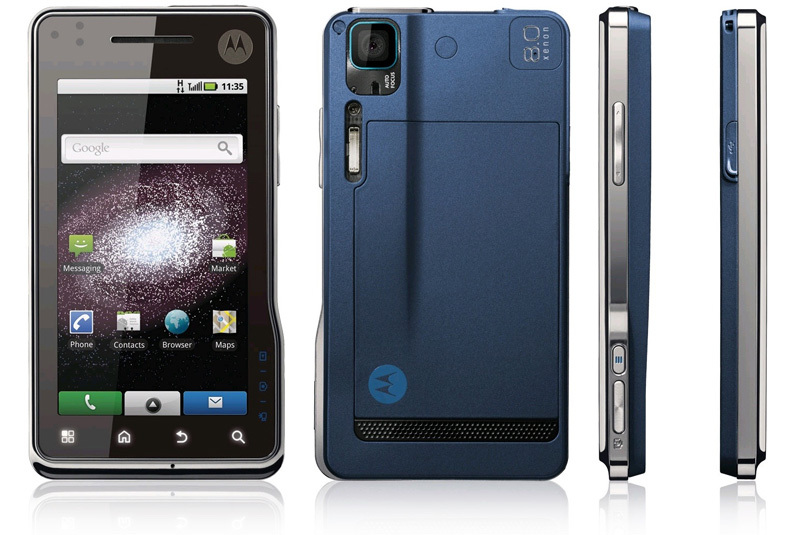
Motorola Milestone XT720
Yes, it was very buggy, did not receive the promised firmware with Android 2.2 and took a terrible picture (despite the 8-megapixel camera with a xenon flash), but what it looked like! I do not know how dear readers, but I was delighted. All this asymmetry, and in a compartment with a blue velvety coating and a metal back cover, did their job - I put up with glitches for six months.
Later, I used the Motorola RAZR XT910. And again I will sing an ode to the design: a small thickness, cut corners, a Kevlar insert on the “pope” ... It was painful to look at the Samsung Galaxy S II - it looked so faint against the background of the “razor”.

Motorola RAZR XT910
Meanwhile, with the software at this very “razor” everything was more than worthy: the convenient Smart Actions program for automatically setting up the smartphone depending on the situation (like “I came home, but the device realized this by using GPS and turned off the sound”), dark blue background of the main menu with a gradient (well, I don’t like the black background, which can be seen in 90% of smarts, including Moto G), the client for accessing the computer’s hard drive over the Internet, screen lock in the style of switching off the lamp TV, tight integration of the gallery with Facebook and music player with las t.fm ... In sum, it created a new sensation from the smartphone, set it apart from others. (All of the above is relevant for firmware from Android 2.3.6, because then an update came from 4.0.4 and 70 percent of the chips disappeared.)
It is clear that many goodies can be added with third-party software. But, in my experience, branded applications embedded in the firmware often work more stable than those downloaded from Google Play ... For example, the Samsung Galaxy S4 has a “black list”, and it functions like a clock. But in Moto G it is not, I have already tried two third-party programs, and they regularly miss messages from the operator.
So, now I hold in my hands Moto G. Branded chips in the software? No, here is almost "naked" Android (I will tell about several unusual applications below). Design? He is definitely pleasant. But no more than that: there is no revolutionism that was clearly seen in the old “Motors” on Android. Taki influence Google? Maybe.
The set of delivery at the smartphone is VERY modest. That's right, VERY. Because it includes only waste paper and a white USB-cord. There is neither a headset, nor a charger unit - the developers assume that you already have such accessories on the farm. (By the way, phones and smartphones for the Japanese market also often come with only one cable - the reason is the one that I indicated above.)

The box is quite compact - a little more than the smartphone itself
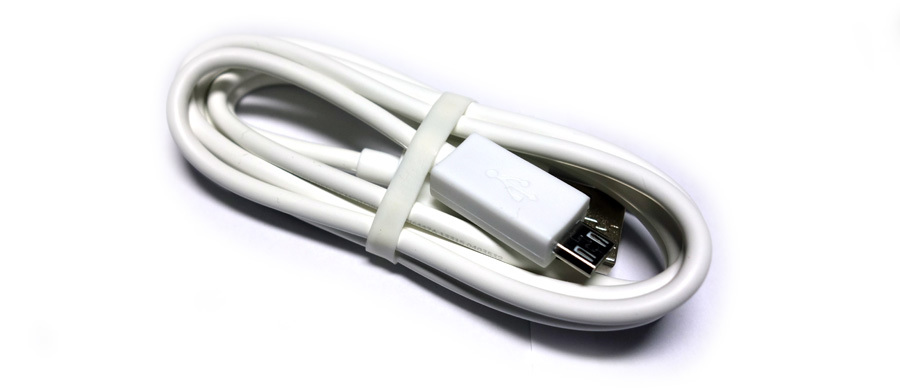
Complete USB cable
Next, it is worth making a reservation that Moto G is sold in black, but interchangeable panels are available as an option. The usual “boat” covers go for $ 15, protected with a rubber bumper - 20 each, and options with a flip (a la Flip Cover for Samsung models) - 30. I have a device with a red panel for $ 15, and here is the black cover that came with it is missing.
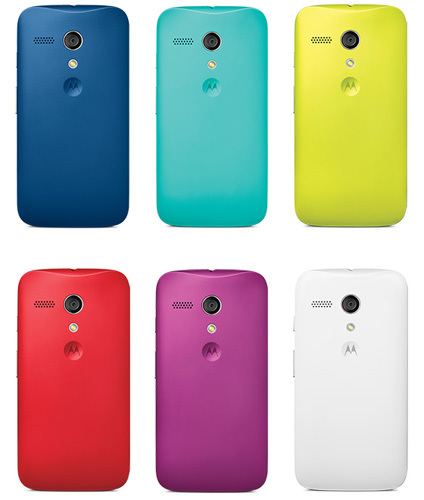
Covers for $ 15
By the way, the packaging of additional backs is very convenient - it can be opened in two accounts, without breaking and breaking:
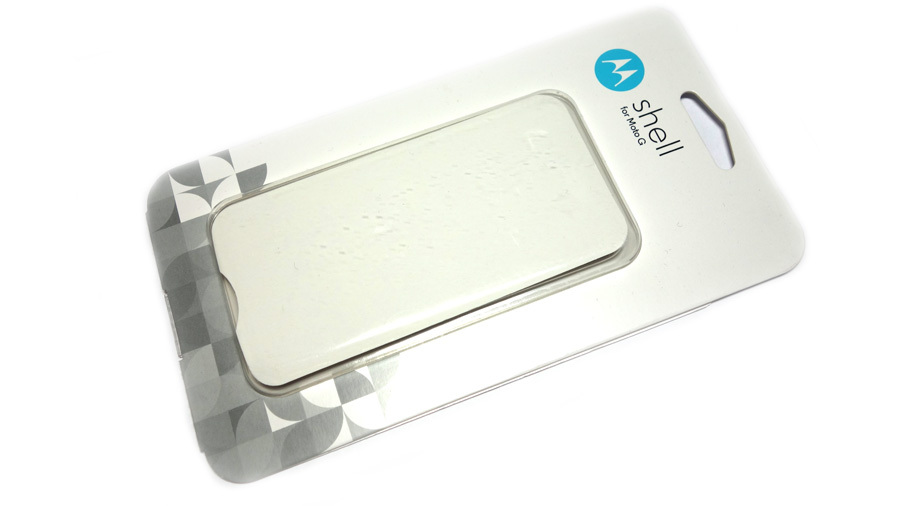
There are no complaints about the assembly of the device - it is very tightly knocked down, and removing the back panel is not easy (I usually help myself with a plastic card). You have to remove it only in order to install / remove the SIM-card. The thing is that the smartphone battery is non-removable, and there is no slot for a flash card. Therefore, I recommend buying Moto G with 16 GB of memory - it is estimated in the US at $ 199. A version with an 8-gigabyte drive costs $ 20 less, so it makes sense to overpay. I will also add that there are several versions of the device - a model with the support of a “global” GSM, an option with an emphasis on American GSM, as well as a CDMA version. There is also a modification with support for two SIM-cards - for Brazil, India and other emerging markets.

There are almost no questions to ergonomics . Vertical shape of the back panel provides a very comfortable grip. The power and volume buttons are on the right side of the case, and they are well spaced - you are not confused, as in the case of some other devices, where these buttons are also located nearby.


The material of the back cover is quite difficult to describe. Let's just say, this is one of the options for soft-touch, and not the softest possible. But it is very pleasant to the touch. I will add that the owner of Samsung Galaxy Win, finished with typical Samsung plastic, whistled as much as he picked up Moto G, I liked it so much. The minus of the coating is that it is quickly salted and begins to shine unevenly. At the same time, it may not be possible to erase divorces and fingerprints “on the shirt”.

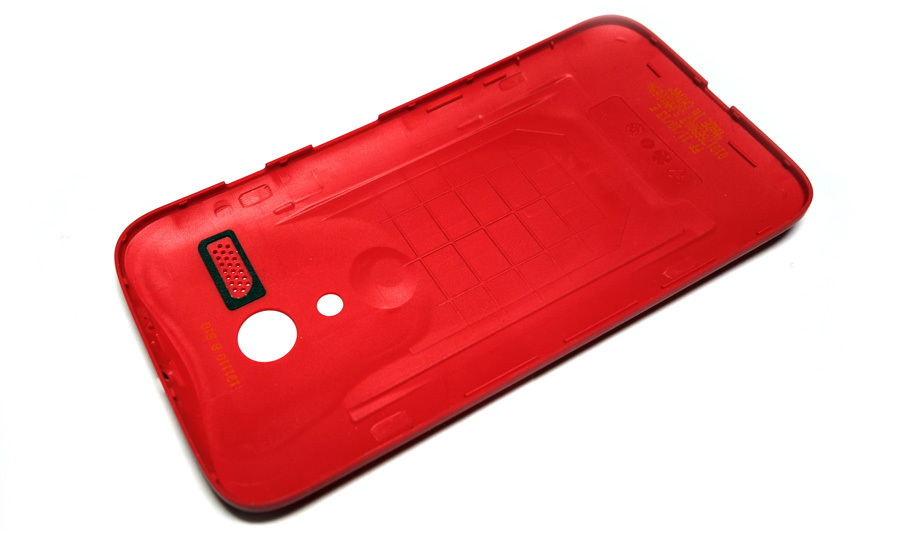

I recently came across a video: www.youtube.com/watch?v=IVaTKG5q4YI . In it, Moto G is dipped into the water for half an hour, and the apparatus at least with henna. In fact, it is better not to conduct such experiments. You never know ... In general, Motorola says that only a water-repellent coating is implemented in Moto G; it implies that the drops will not remain on the body, drying out and leaving specks / stains, but simply draining. The same chip was in the RAZR XT910: www.youtube.com/watch?v=a5s-xDynVXc .
[Turns on the grumble again] I don’t like devices in which the control keys are on the screen - like in Nexus. They eat off the useful area of the display (although some developers have learned how to deal with it - you can hide the panel with buttons, say, in the Lexand A811 tablet), and indeed ... Personally, I never cease to be nostalgic about the hardware buttons for receiving / reject calls. Specifically, in the case of Moto G, the arrangement of the keys on the screen leads to the following: in the Camera application (and it’s just brand here), the last picture is called by swiping your finger from right to left on the right side of the screen, but instead of displaying the photo, Google Now is often launched.

Under the side of the front panel constantly specks of dust
The rest of the design and ergonomics are very happy. Here I will add that the microUSB port is at the bottom (it’s convenient to talk on the phone while charging), while the 3.5 mm headphone jack is on the top.

The conversational speaker and, in general, speech transmission are excellent, and the multimedia speaker perfectly “yells”, and because of the convexity of the back panel, it does not overlap when the smartphone is on the table. As for the sound in the headphones, it is difficult for me to evaluate it, I am far from being an audiophile. But I listened to the same song on the Sony Walkman S763 and Moto G, and I felt the difference clearly. The difference, alas, is not in favor of the smartphone.

The Moto G display is covered with Gorilla Glass 3, and the touchscreen is very sensitive - it is a pleasure to control. Image quality is also excellent. Motorola doesn’t disclose screen technology, saying something like "Moto G uses LCD". Wide viewing angles - not AMOLED, of course, but still not bad. The white color does not yellow, the black color is “serit”, but not so strong as to be upset about it. The ratio of the diagonal (4.5 inches) and resolution (1280 x 720 pixels) gives a very slim image. I don’t see much difference in smoothness with the Galaxy S4, and the LCD color in the Moto G is somewhat nicer than the Super AMOLED in SGS4.
The hardware part of Moto G is not that super-powerful, but far from weak. In this case, the developers decided not to use their own "own" Motorola X8 chipset, but used the Qualcomm platform. (The word "own" is quoted because the X8 was the same Qualcomm as modified by Motorola.) Moto G is based on the 28-nanometer MSM8226 Snapdragon 400 chipset, which includes four ARM Cortex-A7 cores with a peak frequency of 1, 2 GHz and Adreno 305 graphics. (Moto G, by the way, is Motorola’s first and only quad-core smartphone.)
In general, Qualcomm likes to use branded Krait kernels in its platforms, but unmodified ARM is also found in solutions for low-cost devices.
So, the performance is quite high - it is enough for most tasks, although there is not too much RAM here, namely 1 GB. In AnTuTu 10, the smartphone is gaining about 17 thousand points - about the same as the devices on the MediaTek MT6582, which is logical, since there are also four Cortex-A7 cores in this chipset.

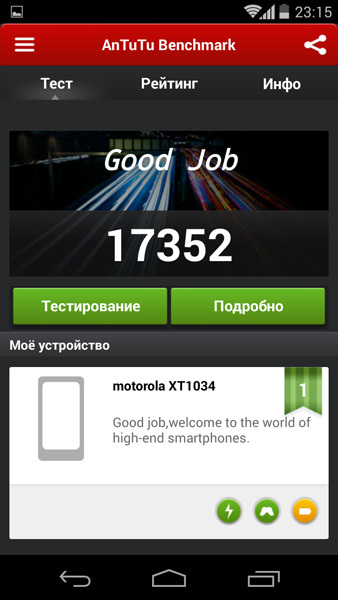
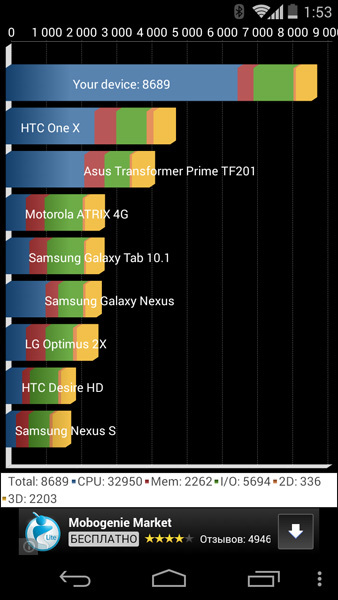
The interface is smart, the games go without any problems and brakes. Here, for example, a screenshot of Asphalt 8, graphics settings are set to maximum.

The Qualcomm MSM8226 Snapdragon 400 includes Bluetooth 4.0 and Wi-Fi (802.11b / g / n) modules, as well as a GLONASS / GPS receiver. I did not find any problems with this whole economy. Specifically, my device, and this is a 16-gigabyte “American” (XT1034), supports GSM / GPRS / EDGE 850/900/1800/1900 MHz and UMTS / HSPA + 850/1700 (AWS) / 1900 MHz networks. Of the 16 gigabytes of memory, about 12.9 are available, and, as I said, it cannot be expanded. In part, this is offset by 50 GB of space on the Google Drive service, which is given for two years in use to all Moto G buyers.
With USB OTG support, the situation is interesting. I read the forums - someone works, someone does not, and I somehow half: the device did not see any of the three USB flash drives on the farm, but the wired mouse worked fine.

Next we have a camera, or rather, a camera. Front 1.3 MP, for Skype amiss. The main has a resolution of 5 megapixel autofocus and LED flash. Image resolution cannot be selected, only the aspect ratio is 16: 9 or 4: 3. It is possible to add geotags, panorama mode, HDR and a couple of options. Autofocus is available, focusing on the touch is supported, albeit in a peculiar way: you need to drag a special circle on the screen with your finger and stop where you want to focus. If you simply poke your finger in some place on the left or on the right, Moto G will take a photo focusing on the frame.

As I already said, the interface of the camera application is corporate - and simplified compared to what can be seen in the stock Android'e. It looks like this:

The quality of shots in sunny weather seems to be good, but you shouldn’t idealize Moto G - developers had to save on something. They saved it on camera, and although it still gives out pictures above average, I would not attribute this device to the class “replacement soap box” (unlike SGS4, for example).







Once again, I’m very annoyed by the constant random launches of Google Now instead of opening the last snapshot. Well, very straight.

Video smartphone records in maximum resolution HD720p.
I also add that the flash can act as a flashlight, but there is no special application for this. Since the time of the Motorola RAZR XT910, I use a program from Motorola itself - called the DroidLight.
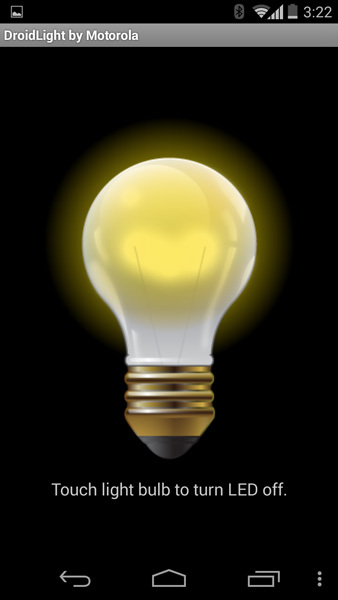
Regarding software. Moto G went on sale with Android 4.3, but the developers immediately promised to release the firmware from Android 4.4.2 KitKat.
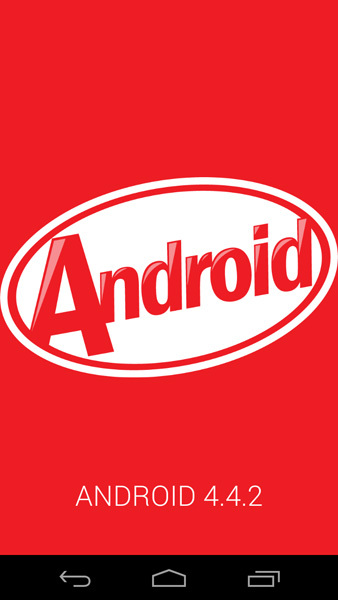


With my smartphone, the situation is as follows: the first owner Russified him (initially in the Moto G firmware, the great and powerful is not) by popular methods, got the root - in general, experimented with the software. It turned out not very neatly: for example, for some reason, two email clients were displayed in the menu, and when I tried to start one of them, it gave an error and closed. I had to remove this client using Uninstaller Pro. But there are no questions to the Russification: the interface has now been transferred to 90 percent, occasionally menus and other pieces come out in English. If you need a device that is Russified out of the box, then you should take Moto G Google Play Edition - there is Russian right away. But there is no pre-installed software from Motorola.

Moto G Google Play Edition
What software are we talking about? The first program is Motorola Boot Services. As I understand it, it can change the animation when turned on, depending on the season, holiday or other factors. Assist is a kind of Smart Actions, an application, for example, can automatically turn off the sound at a certain time (when you go to bed), while making an exception for the specified important numbers.


Motorola Migrate is designed to "move" to Moto G from any other smartphone on the Android operating system or even the iPhone.

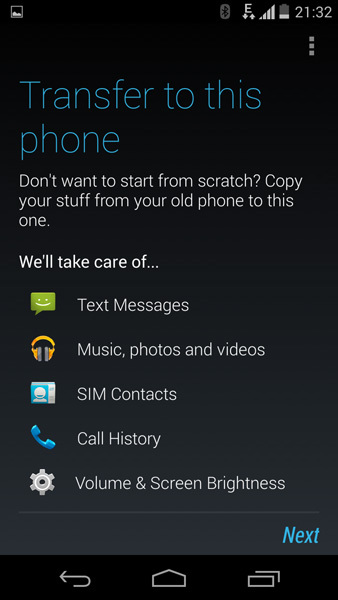
I was somewhat surprised (in a positive sense) by the developers' approach to updating individual firmware components. After all, as it happens - if programmers found a glitch in the Camera application, then they can fix it only in the next firmware, which will have to be installed entirely. Moto G has a different situation: “Camera”, “FM-radio” and “Gallery” are updated from Google Play, which is very convenient.
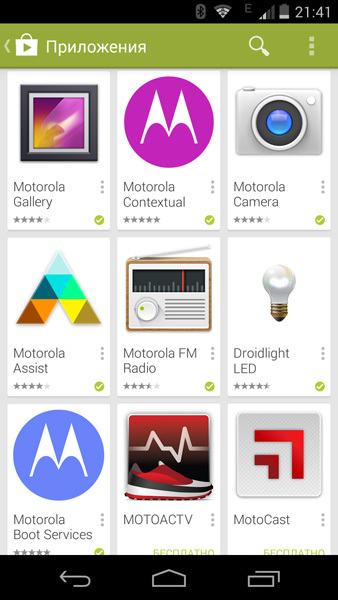
Initially, the "Gallery" was standard, from the composition of Android, and then the device suddenly downloaded and installed the brand, which replaced the standard one. The photo album is simple, but you can live, although personally I’d hardly ever change QuickPic.
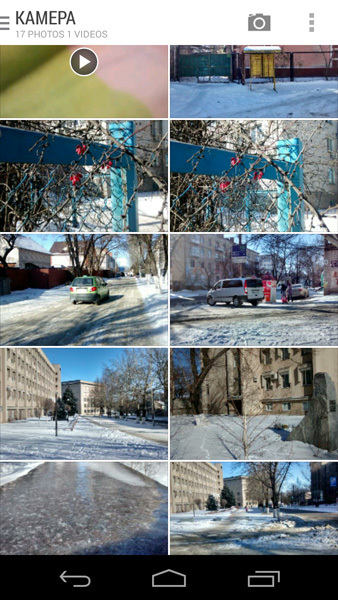


Another couple of unusual, but not too important moments. In the settings there is a point that allows you to enable the sending of information, which in theory will allow developers to make Motorola smartphones better. And there, in the settings, you can enter your email and get a Motorola Device ID, which allows, say, to search for a phone on the map. Although this option is already basic in Android, so there is not much benefit from it.


I also note that a very nice set of wallpapers is pre-installed on the smartphone. Motorola is generally one of the few companies that can correctly select pre-installed content. He drew attention to this in the days of the Motorola Z6.


There is nothing more to say about the software, everything works stably and quickly. Glitches for the month of operation was only two. The first one looked like this:

A couple of times turned off / on the screen - and everything went.
The second glitch concerns screenshots. Above, I brought a screen from the game Asphalt 8, and so it turned out to make attempts from the fifth. When you click on the bottom of the swing volume control and the power button, Moto G started taking screenshots nonstop, but then they did not appear in the memory. Trifle, of course, and yet.
For the order - some more screenshots of the interface:
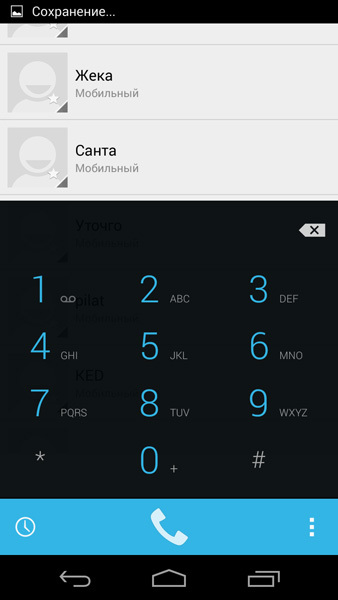


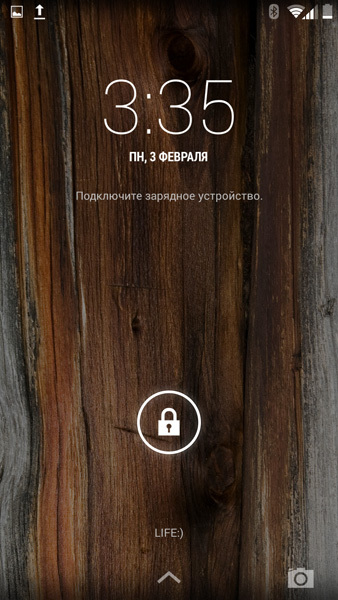
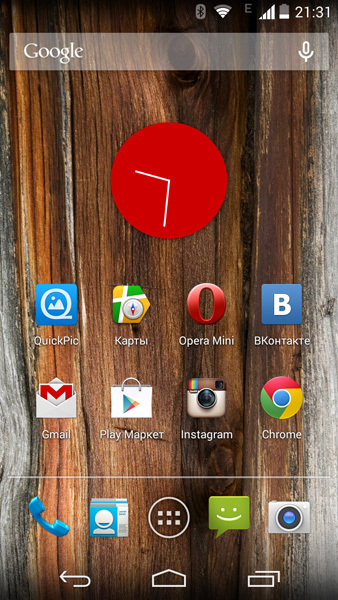
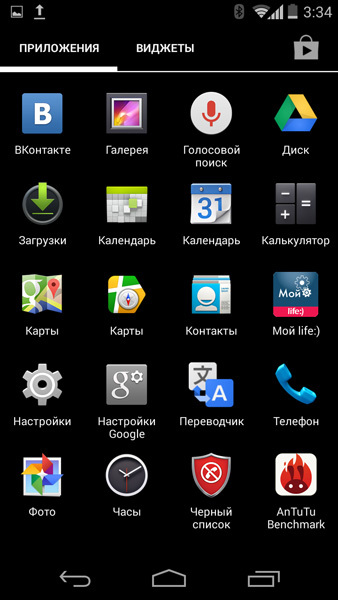
A few words about autonomous work . Up to two days Moto G lives stably - under the conditions of connecting to a 2G network and about an hour of conversations per day. Occasionally photos, a bit of games, correspondence in the "contact" and, in principle, everything. I think it will be quite simple to discharge the smartphone in 24 hours with active use.
Finally, I will say this. When I got a Moto G and searched for it for a day, I experienced a deja vu. The device seemed very familiar. Then I realized what was the matter. Moto G is very similar to the Highscreen Omega Prime Mini, which I went with in the fall. Other than jokes. Yes, it is Moto G that is similar to Highscreen, and not vice versa, since Highscreen was announced and went on sale much earlier - in the middle of autumn. (Naturally, this is just a curiosity, nobody copied anything from Highscreen.)
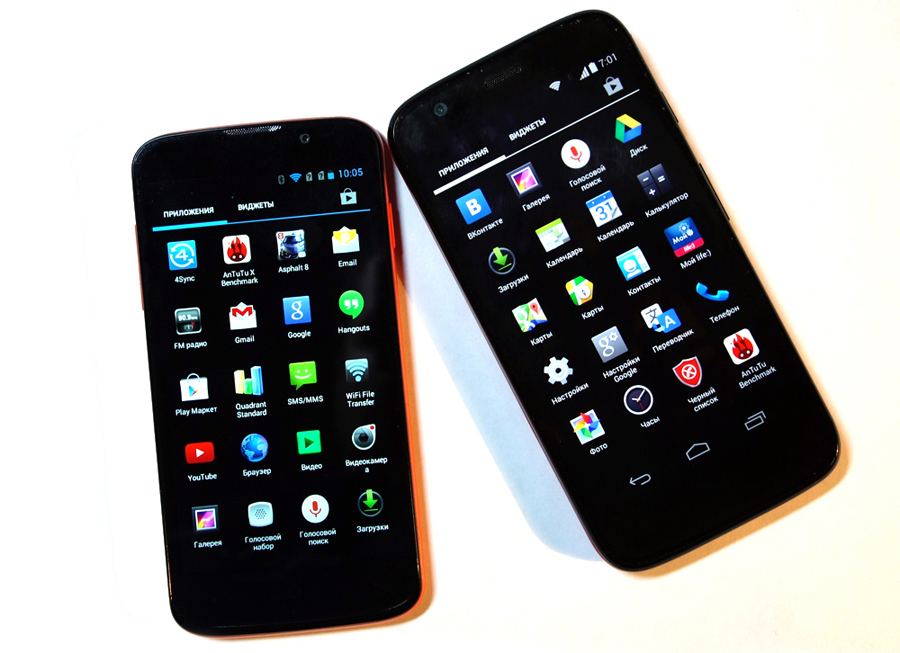
Highscreen Omega Prime Mini and Moto G
What do smartphones look like? Both are compact by modern standards once (Highscreen 4.3-inch). Both have non-removable batteries - two. Both have a front panel with a small side - three. Both have a Qualcomm platform (although Moto G is much more modern) - four. In both cases, the emphasis is on the colored covers - five (with Highscreen, five panels are included, and for Moto G they will have to be bought). The cover of the back of the Moto G is very similar to the cover of some Highscreen Omega Prime Mini covers in terms of tactile sensations - six (for the Highscreen the red and orange panels are opaque, and the blue, black and white are slightly rough, just like Motorola). Plus, the screens are similar in color. In general, if you close the logos, it may seem that these are products of one office. On the Moto G side, a higher screen resolution, more powerful battery (2,070 vs. 1,600) and iron, as well as a newer version of the operating system. On the Highscreen side, there is support for two SIM cards, a memory card slot, an 8 megapixel camera, and a noticeably smaller thickness.

Top Highscreen, bottom - Moto G
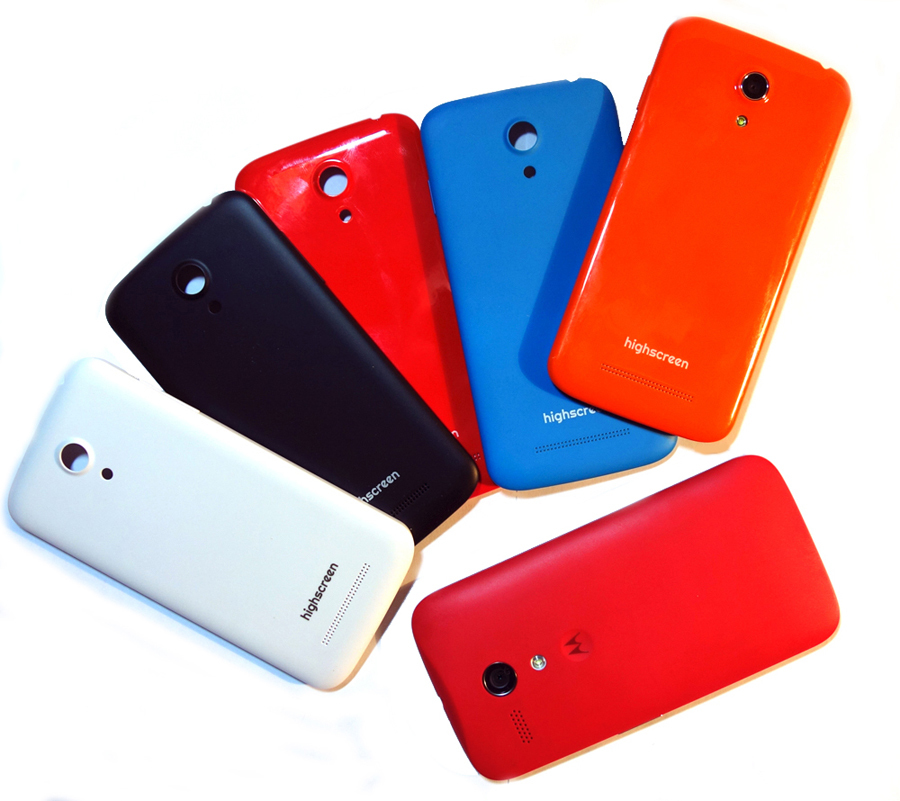
Summarize the experience. Do I like Moto G? Definitely. Would I buy it myself? Yes, already bought. But only for the role of the second device: for the role of the first one in my particular case, the screen is too small, the camera is not very good, the internal memory is not enough. If all this is not critical for you and you are not afraid of the lack of a guarantee, then go ahead, this is truly one of the successful options for your money.Moreover, it is better to independently order Moto G “from abroad”: in Russia, 10-11 thousand may be asked for the 8 GB option, and 12-13 for the 16 GB version. And this is a little expensive.

Lenovo K900 and Moto G
Anyway, today we’ll talk specifically about Moto G. On the Internet, it’s customary to praise this device - they say, the best budget offer, an excellent smartphone for “crutches of dandies”, a killer of products of local Russian brands and so on. Yes, indeed, I will already run ahead now and say that the smartphone is decent. And it may very well be that I will leave it for a couple of months as a second device. But, at the same time, I can’t stop smoking a bit - I have enough reasons for this, as a user of a number of Android-based Motorola smartphones from 2010-2011, suffices.
What have I always liked “Motors” with Android inside? Unusual approach to design and software. (I should immediately say that I am not a fan of the stock versions of this OS and I love all sorts of shells with small pleasant chips.) For example, the Motorola Milestone XT720 is one of the latest Motorola devices shipped to Russia.
')

Motorola Milestone XT720
Yes, it was very buggy, did not receive the promised firmware with Android 2.2 and took a terrible picture (despite the 8-megapixel camera with a xenon flash), but what it looked like! I do not know how dear readers, but I was delighted. All this asymmetry, and in a compartment with a blue velvety coating and a metal back cover, did their job - I put up with glitches for six months.
Later, I used the Motorola RAZR XT910. And again I will sing an ode to the design: a small thickness, cut corners, a Kevlar insert on the “pope” ... It was painful to look at the Samsung Galaxy S II - it looked so faint against the background of the “razor”.

Motorola RAZR XT910
Meanwhile, with the software at this very “razor” everything was more than worthy: the convenient Smart Actions program for automatically setting up the smartphone depending on the situation (like “I came home, but the device realized this by using GPS and turned off the sound”), dark blue background of the main menu with a gradient (well, I don’t like the black background, which can be seen in 90% of smarts, including Moto G), the client for accessing the computer’s hard drive over the Internet, screen lock in the style of switching off the lamp TV, tight integration of the gallery with Facebook and music player with las t.fm ... In sum, it created a new sensation from the smartphone, set it apart from others. (All of the above is relevant for firmware from Android 2.3.6, because then an update came from 4.0.4 and 70 percent of the chips disappeared.)
It is clear that many goodies can be added with third-party software. But, in my experience, branded applications embedded in the firmware often work more stable than those downloaded from Google Play ... For example, the Samsung Galaxy S4 has a “black list”, and it functions like a clock. But in Moto G it is not, I have already tried two third-party programs, and they regularly miss messages from the operator.
So, now I hold in my hands Moto G. Branded chips in the software? No, here is almost "naked" Android (I will tell about several unusual applications below). Design? He is definitely pleasant. But no more than that: there is no revolutionism that was clearly seen in the old “Motors” on Android. Taki influence Google? Maybe.
The set of delivery at the smartphone is VERY modest. That's right, VERY. Because it includes only waste paper and a white USB-cord. There is neither a headset, nor a charger unit - the developers assume that you already have such accessories on the farm. (By the way, phones and smartphones for the Japanese market also often come with only one cable - the reason is the one that I indicated above.)

The box is quite compact - a little more than the smartphone itself

Complete USB cable
Next, it is worth making a reservation that Moto G is sold in black, but interchangeable panels are available as an option. The usual “boat” covers go for $ 15, protected with a rubber bumper - 20 each, and options with a flip (a la Flip Cover for Samsung models) - 30. I have a device with a red panel for $ 15, and here is the black cover that came with it is missing.

Covers for $ 15
By the way, the packaging of additional backs is very convenient - it can be opened in two accounts, without breaking and breaking:

There are no complaints about the assembly of the device - it is very tightly knocked down, and removing the back panel is not easy (I usually help myself with a plastic card). You have to remove it only in order to install / remove the SIM-card. The thing is that the smartphone battery is non-removable, and there is no slot for a flash card. Therefore, I recommend buying Moto G with 16 GB of memory - it is estimated in the US at $ 199. A version with an 8-gigabyte drive costs $ 20 less, so it makes sense to overpay. I will also add that there are several versions of the device - a model with the support of a “global” GSM, an option with an emphasis on American GSM, as well as a CDMA version. There is also a modification with support for two SIM-cards - for Brazil, India and other emerging markets.

There are almost no questions to ergonomics . Vertical shape of the back panel provides a very comfortable grip. The power and volume buttons are on the right side of the case, and they are well spaced - you are not confused, as in the case of some other devices, where these buttons are also located nearby.


The material of the back cover is quite difficult to describe. Let's just say, this is one of the options for soft-touch, and not the softest possible. But it is very pleasant to the touch. I will add that the owner of Samsung Galaxy Win, finished with typical Samsung plastic, whistled as much as he picked up Moto G, I liked it so much. The minus of the coating is that it is quickly salted and begins to shine unevenly. At the same time, it may not be possible to erase divorces and fingerprints “on the shirt”.



I recently came across a video: www.youtube.com/watch?v=IVaTKG5q4YI . In it, Moto G is dipped into the water for half an hour, and the apparatus at least with henna. In fact, it is better not to conduct such experiments. You never know ... In general, Motorola says that only a water-repellent coating is implemented in Moto G; it implies that the drops will not remain on the body, drying out and leaving specks / stains, but simply draining. The same chip was in the RAZR XT910: www.youtube.com/watch?v=a5s-xDynVXc .
[Turns on the grumble again] I don’t like devices in which the control keys are on the screen - like in Nexus. They eat off the useful area of the display (although some developers have learned how to deal with it - you can hide the panel with buttons, say, in the Lexand A811 tablet), and indeed ... Personally, I never cease to be nostalgic about the hardware buttons for receiving / reject calls. Specifically, in the case of Moto G, the arrangement of the keys on the screen leads to the following: in the Camera application (and it’s just brand here), the last picture is called by swiping your finger from right to left on the right side of the screen, but instead of displaying the photo, Google Now is often launched.

Under the side of the front panel constantly specks of dust
The rest of the design and ergonomics are very happy. Here I will add that the microUSB port is at the bottom (it’s convenient to talk on the phone while charging), while the 3.5 mm headphone jack is on the top.

The conversational speaker and, in general, speech transmission are excellent, and the multimedia speaker perfectly “yells”, and because of the convexity of the back panel, it does not overlap when the smartphone is on the table. As for the sound in the headphones, it is difficult for me to evaluate it, I am far from being an audiophile. But I listened to the same song on the Sony Walkman S763 and Moto G, and I felt the difference clearly. The difference, alas, is not in favor of the smartphone.

The Moto G display is covered with Gorilla Glass 3, and the touchscreen is very sensitive - it is a pleasure to control. Image quality is also excellent. Motorola doesn’t disclose screen technology, saying something like "Moto G uses LCD". Wide viewing angles - not AMOLED, of course, but still not bad. The white color does not yellow, the black color is “serit”, but not so strong as to be upset about it. The ratio of the diagonal (4.5 inches) and resolution (1280 x 720 pixels) gives a very slim image. I don’t see much difference in smoothness with the Galaxy S4, and the LCD color in the Moto G is somewhat nicer than the Super AMOLED in SGS4.
The hardware part of Moto G is not that super-powerful, but far from weak. In this case, the developers decided not to use their own "own" Motorola X8 chipset, but used the Qualcomm platform. (The word "own" is quoted because the X8 was the same Qualcomm as modified by Motorola.) Moto G is based on the 28-nanometer MSM8226 Snapdragon 400 chipset, which includes four ARM Cortex-A7 cores with a peak frequency of 1, 2 GHz and Adreno 305 graphics. (Moto G, by the way, is Motorola’s first and only quad-core smartphone.)
In general, Qualcomm likes to use branded Krait kernels in its platforms, but unmodified ARM is also found in solutions for low-cost devices.
So, the performance is quite high - it is enough for most tasks, although there is not too much RAM here, namely 1 GB. In AnTuTu 10, the smartphone is gaining about 17 thousand points - about the same as the devices on the MediaTek MT6582, which is logical, since there are also four Cortex-A7 cores in this chipset.



The interface is smart, the games go without any problems and brakes. Here, for example, a screenshot of Asphalt 8, graphics settings are set to maximum.

The Qualcomm MSM8226 Snapdragon 400 includes Bluetooth 4.0 and Wi-Fi (802.11b / g / n) modules, as well as a GLONASS / GPS receiver. I did not find any problems with this whole economy. Specifically, my device, and this is a 16-gigabyte “American” (XT1034), supports GSM / GPRS / EDGE 850/900/1800/1900 MHz and UMTS / HSPA + 850/1700 (AWS) / 1900 MHz networks. Of the 16 gigabytes of memory, about 12.9 are available, and, as I said, it cannot be expanded. In part, this is offset by 50 GB of space on the Google Drive service, which is given for two years in use to all Moto G buyers.
With USB OTG support, the situation is interesting. I read the forums - someone works, someone does not, and I somehow half: the device did not see any of the three USB flash drives on the farm, but the wired mouse worked fine.

Next we have a camera, or rather, a camera. Front 1.3 MP, for Skype amiss. The main has a resolution of 5 megapixel autofocus and LED flash. Image resolution cannot be selected, only the aspect ratio is 16: 9 or 4: 3. It is possible to add geotags, panorama mode, HDR and a couple of options. Autofocus is available, focusing on the touch is supported, albeit in a peculiar way: you need to drag a special circle on the screen with your finger and stop where you want to focus. If you simply poke your finger in some place on the left or on the right, Moto G will take a photo focusing on the frame.

As I already said, the interface of the camera application is corporate - and simplified compared to what can be seen in the stock Android'e. It looks like this:

The quality of shots in sunny weather seems to be good, but you shouldn’t idealize Moto G - developers had to save on something. They saved it on camera, and although it still gives out pictures above average, I would not attribute this device to the class “replacement soap box” (unlike SGS4, for example).







Once again, I’m very annoyed by the constant random launches of Google Now instead of opening the last snapshot. Well, very straight.

Video smartphone records in maximum resolution HD720p.
I also add that the flash can act as a flashlight, but there is no special application for this. Since the time of the Motorola RAZR XT910, I use a program from Motorola itself - called the DroidLight.

Regarding software. Moto G went on sale with Android 4.3, but the developers immediately promised to release the firmware from Android 4.4.2 KitKat.



With my smartphone, the situation is as follows: the first owner Russified him (initially in the Moto G firmware, the great and powerful is not) by popular methods, got the root - in general, experimented with the software. It turned out not very neatly: for example, for some reason, two email clients were displayed in the menu, and when I tried to start one of them, it gave an error and closed. I had to remove this client using Uninstaller Pro. But there are no questions to the Russification: the interface has now been transferred to 90 percent, occasionally menus and other pieces come out in English. If you need a device that is Russified out of the box, then you should take Moto G Google Play Edition - there is Russian right away. But there is no pre-installed software from Motorola.

Moto G Google Play Edition
What software are we talking about? The first program is Motorola Boot Services. As I understand it, it can change the animation when turned on, depending on the season, holiday or other factors. Assist is a kind of Smart Actions, an application, for example, can automatically turn off the sound at a certain time (when you go to bed), while making an exception for the specified important numbers.


Motorola Migrate is designed to "move" to Moto G from any other smartphone on the Android operating system or even the iPhone.


I was somewhat surprised (in a positive sense) by the developers' approach to updating individual firmware components. After all, as it happens - if programmers found a glitch in the Camera application, then they can fix it only in the next firmware, which will have to be installed entirely. Moto G has a different situation: “Camera”, “FM-radio” and “Gallery” are updated from Google Play, which is very convenient.

Initially, the "Gallery" was standard, from the composition of Android, and then the device suddenly downloaded and installed the brand, which replaced the standard one. The photo album is simple, but you can live, although personally I’d hardly ever change QuickPic.



Another couple of unusual, but not too important moments. In the settings there is a point that allows you to enable the sending of information, which in theory will allow developers to make Motorola smartphones better. And there, in the settings, you can enter your email and get a Motorola Device ID, which allows, say, to search for a phone on the map. Although this option is already basic in Android, so there is not much benefit from it.


I also note that a very nice set of wallpapers is pre-installed on the smartphone. Motorola is generally one of the few companies that can correctly select pre-installed content. He drew attention to this in the days of the Motorola Z6.


There is nothing more to say about the software, everything works stably and quickly. Glitches for the month of operation was only two. The first one looked like this:

A couple of times turned off / on the screen - and everything went.
The second glitch concerns screenshots. Above, I brought a screen from the game Asphalt 8, and so it turned out to make attempts from the fifth. When you click on the bottom of the swing volume control and the power button, Moto G started taking screenshots nonstop, but then they did not appear in the memory. Trifle, of course, and yet.
For the order - some more screenshots of the interface:






A few words about autonomous work . Up to two days Moto G lives stably - under the conditions of connecting to a 2G network and about an hour of conversations per day. Occasionally photos, a bit of games, correspondence in the "contact" and, in principle, everything. I think it will be quite simple to discharge the smartphone in 24 hours with active use.
Finally, I will say this. When I got a Moto G and searched for it for a day, I experienced a deja vu. The device seemed very familiar. Then I realized what was the matter. Moto G is very similar to the Highscreen Omega Prime Mini, which I went with in the fall. Other than jokes. Yes, it is Moto G that is similar to Highscreen, and not vice versa, since Highscreen was announced and went on sale much earlier - in the middle of autumn. (Naturally, this is just a curiosity, nobody copied anything from Highscreen.)

Highscreen Omega Prime Mini and Moto G
What do smartphones look like? Both are compact by modern standards once (Highscreen 4.3-inch). Both have non-removable batteries - two. Both have a front panel with a small side - three. Both have a Qualcomm platform (although Moto G is much more modern) - four. In both cases, the emphasis is on the colored covers - five (with Highscreen, five panels are included, and for Moto G they will have to be bought). The cover of the back of the Moto G is very similar to the cover of some Highscreen Omega Prime Mini covers in terms of tactile sensations - six (for the Highscreen the red and orange panels are opaque, and the blue, black and white are slightly rough, just like Motorola). Plus, the screens are similar in color. In general, if you close the logos, it may seem that these are products of one office. On the Moto G side, a higher screen resolution, more powerful battery (2,070 vs. 1,600) and iron, as well as a newer version of the operating system. On the Highscreen side, there is support for two SIM cards, a memory card slot, an 8 megapixel camera, and a noticeably smaller thickness.

Top Highscreen, bottom - Moto G

Summarize the experience. Do I like Moto G? Definitely. Would I buy it myself? Yes, already bought. But only for the role of the second device: for the role of the first one in my particular case, the screen is too small, the camera is not very good, the internal memory is not enough. If all this is not critical for you and you are not afraid of the lack of a guarantee, then go ahead, this is truly one of the successful options for your money.Moreover, it is better to independently order Moto G “from abroad”: in Russia, 10-11 thousand may be asked for the 8 GB option, and 12-13 for the 16 GB version. And this is a little expensive.
Source: https://habr.com/ru/post/211248/
All Articles